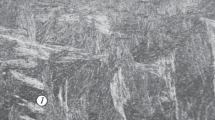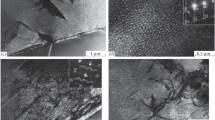Conclusions
-
1.
The validity of evaluating titanium alloy thermal stability in a given temperature range depends to a certain degree on the study method.
-
2.
The thermal stability of α-titanium alloys cannot be reliably evaluated from ductility values (primarily relative elongation) with static tests on smooth specimens.
-
3.
Endurance in the low-cycle fatigue region for notched specimens in a corrosive medium is a more sensitive property compared with impact strength; the start of its reduction corresponds either to appearance of ordered α-phase in the structure, or to the stage of aging preceding its appearance.
-
4.
A study of the kinetics of the reduction in low-cycle endurance after aging for notched specimens of α- or pseudo-α-titanium alloys containing not more than 6 wt. % aluminum during low-cycle endurance tests in a corrosive medium makes it possible to detect the early stages of α-solid solution decomposition; this is formation of microsegregates enriched in alloying elements and differing in electrochemical potential from the matrix.
Similar content being viewed by others

Literature cited
S. G. Glazunov and V. N. Moiseev, Structural Titanium Alloys [in Russian], Metallurgiya, Moscow (1974).
B. A. Kolachev et al., Mechanical Properties of Titanium and Its Alloys [in Russian], Metallurgiya, Moscow (1974).
V. V. Vavilova et al., "Oxygen in Ti−Al alloys," Metalloved Term. Obrab. Met., No. 3, 44 (1975).
O. S. Korobov et al., "Oxygen in alloys of titanium with aluminum and zirconium," Metalloved. Term. Obrab. Met., No. 4, 36 (1973).
B. A. Kolachev and S. M. Fainbron, "Effect of quenching from the α-region and subsequent tempering on the mechanical properties of alloy VT5-1," in: Structure and Properties of Aviation Steels and Alloys [in Russian], Mashinostroenie, Moscow (1966).
A. M. Parshin et al., Structure, Strength, and Ductility of Dispersion-Hardened β-Titanium Alloy and Rational Areas for Its Use [in Russian], LDNTP, Leningrad (1973).
T. Namboodhiri et al., Met. Trans.,4, No. 5, 1323 (1973).
O. S. Korobov et al., "Phase transformations in heat-treated alloy VT18," in: New Structural Materials [in Russian], Nauka, Moscow (1972).
F. Crossly, Met. Trans.,1, No. 5, 1921 (1970).
M. B. Bodunova et al., "Nature of α-alloy embrittlement during aging," Metalloved. Term. Obrab. Met., No. 5, 46 (1977).
Additional information
Translated from Metallovedenie i Termicheskaya Obrabotka Metallov, No. 12, pp. 37–39, December, 1981.
Rights and permissions
About this article
Cite this article
Zhukov, V.A., Ivanova, L.A., Marinets, T.K. et al. Thermal stability of pseudo-α-titanium alloys and methods for evaluation. Met Sci Heat Treat 23, 854–857 (1981). https://doi.org/10.1007/BF00712466
Issue Date:
DOI: https://doi.org/10.1007/BF00712466



